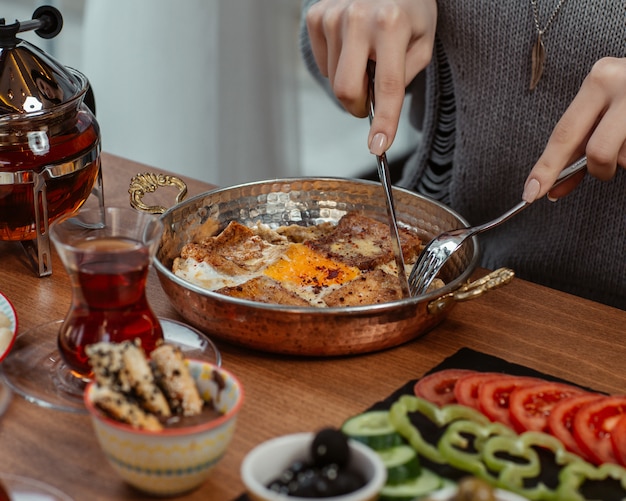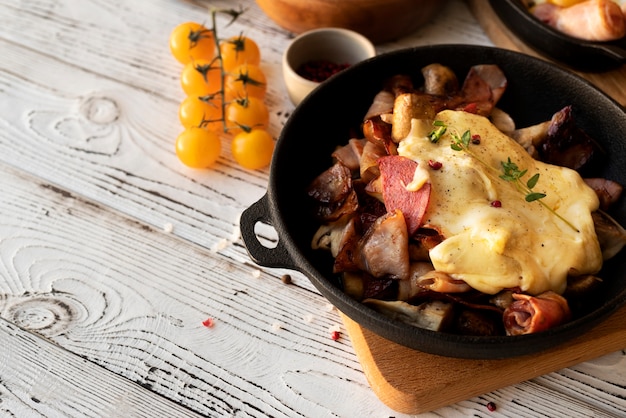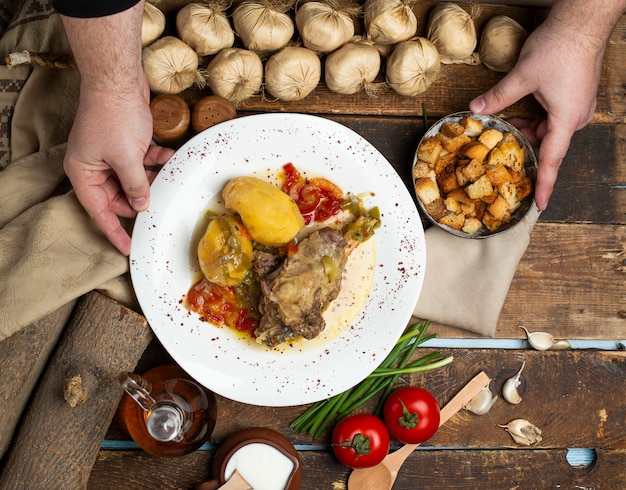There’s something undeniably comforting about a steaming bowl of hearty stew, bursting with tender meat, vibrant vegetables, and a rich, flavorful broth. It's a dish that evokes memories of cozy evenings by the fire, a warm hug on a chilly day, and the satisfaction of a home-cooked meal. But let's be honest, making a truly exceptional stew isn’t always as straightforward as it seems. It takes a bit of culinary know-how to ensure the meat melts in your mouth and the flavors are perfectly balanced.
Over the years, I’ve experimented with countless recipes and techniques, learning from both triumphs and mishaps in the kitchen. I’ve discovered the secrets to transforming seemingly tough cuts of meat into succulent masterpieces, and I’m excited to share my insider knowledge with you. In this article, we’ll embark on a journey together, exploring the key elements of a perfect stew, from choosing the right cut of meat to mastering the art of slow cooking and finishing with irresistible final touches. So, grab your apron, gather your ingredients, and let's get started!
(Part 1) The Meat Matters: Choosing the Right Cut

The first step to a truly delicious stew is selecting the right cut of meat. Think of it like choosing the foundation of a house; a sturdy foundation is essential for a strong and stable structure. The same applies to stew. The right cut of meat will set the stage for a truly satisfying and flavorful dish.
The Importance of Tough Cuts
You might be surprised to learn that those often-overlooked tough cuts of meat are your secret weapon when it comes to stewing. Cuts like chuck roast, brisket, and short ribs are packed with collagen and connective tissue, which is where the magic happens. When cooked slowly over low heat, this collagen breaks down into gelatin. This process transforms the tough fibers into a silky, melt-in-your-mouth texture that makes stew so irresistible. It's like alchemy in the kitchen!
Cuts to Avoid
While tough cuts are your best friends, tender cuts like filet mignon or sirloin are best suited for quick cooking methods, like grilling or pan-searing. They don't possess the same abundance of collagen, and slow cooking can actually dry them out, making them tough and flavorless. Save those tender cuts for other culinary adventures.
My Go-To Cuts for Stew
My personal favorites for stewing are chuck roast and short ribs. They offer a beautiful balance of fat and connective tissue, resulting in a rich, flavorful broth and incredibly tender meat. But don't be afraid to experiment with other cuts like brisket, oxtail, or even lamb shanks. The key is to choose cuts specifically designed for slow cooking.
Understanding Different Cuts
Here's a quick guide to some common stew cuts, highlighting their characteristics and potential uses:
| Cut | Characteristics | Best Uses |
|---|---|---|
| Chuck Roast | Full of flavor and marbling, good for slow cooking | Stews, braises, pot roasts |
| Brisket | Tough but flavorful, requires long cooking time | Stews, pulled beef, barbecue |
| Short Ribs | Tender and rich, ideal for slow cooking | Stews, braises, pot roasts |
| Oxtail | Full of gelatin, rich and flavorful | Stews, soups, braises |
| Lamb Shanks | Tender and flavorful, requires long cooking time | Stews, braises, roasts |
(Part 2) Mastering the Art of Tenderizing

Now that you've chosen your ideal cut of meat, it's time to embark on the tenderizing process. This is where patience and a little culinary magic come into play. We're going to transform tough cuts into succulent, flavorful masterpieces, ready to melt in your mouth.
The Power of Time and Heat
The most effective way to tenderize stew meat is by slow cooking it over low heat. This allows the collagen to break down gradually, creating that incredible melt-in-your-mouth texture. It's like a slow dance, where time and heat work together to transform the meat. Think of it as a culinary ballet!
My trusty slow cooker is my go-to tool for this process, but you can also achieve the same results using a dutch oven or even a regular pot on the stovetop. The key is to maintain a low and steady temperature, allowing the meat to cook gently for an extended period.
Don't Forget the Liquid!
Liquid plays a vital role in tenderizing meat. Water alone isn't enough; we need something that will enhance the flavors and create a delicious broth. I often use beef broth or stock, which adds a depth of flavor and helps to extract the natural juices from the meat. But don't be afraid to get creative! Wine, beer, or even tomato juice can all add unique and delicious flavors to your stew.
A Touch of Acid
A touch of acid can also work wonders for tenderizing meat and adding another layer of complexity to the flavor. I like to add a splash of red wine vinegar or lemon juice to my stew. The acid helps to break down the tough protein fibers, resulting in tender, flavorful meat.
Seasoning Strategies
Seasoning your meat is crucial for a truly flavorful stew. Don't hold back on the salt and pepper! They are essential for enhancing the natural flavors of the meat. You can also get creative with spices and herbs. I love to use a blend of thyme, rosemary, and bay leaves for a classic, earthy flavor. Garlic powder, onion powder, paprika, and cumin can also add depth and warmth. Remember to season liberally, as the flavors will meld together during the long cooking process.
The Art of Salt: A Closer Look
Salt plays a key role in tenderizing meat. When you salt meat, the salt draws out moisture, causing the proteins to tighten up. However, as the meat cooks, the salt penetrates deeper and breaks down the protein fibers, resulting in a more tender texture.
Using the Right Salt
For stewing, I prefer kosher salt for its larger crystals and less salty taste. Table salt can be too strong and can overwhelm the delicate flavors of the stew.
Timing is Key
When salting meat for stewing, it's best to season it several hours or even a day in advance. This allows the salt to penetrate the meat more effectively, resulting in a more flavorful and tender final product.
(Part 3) The Importance of Browning

Before we embark on the slow cooking journey, we need to give our meat a little star treatment. Browning, also known as searing, is a crucial step that adds a delicious depth of flavor and creates a beautiful, rich broth.
The Technique
To brown your meat, heat a large skillet or Dutch oven over medium-high heat. Add a bit of oil or butter to the pan. This will create a layer that prevents the meat from sticking and allows it to develop a beautiful golden-brown crust. Next, sear the meat on all sides, ensuring each side develops a nice, even color. Don't overcrowd the pan; give the meat enough space to brown evenly.
Why Browning Matters
Browning creates a chemical reaction known as the Maillard reaction, which is responsible for the delicious, savory flavors in countless cooked foods. It's the magic behind the caramelized crust on grilled meats, the toasty aroma of roasted vegetables, and the irresistible scent of freshly baked bread. This reaction also helps to form a crust that seals in the moisture and flavor of the meat, creating a more flavorful stew.
Don't Forget the Leftovers!
The browned bits left behind in the pan, called fond, are a treasure trove of flavor. Don't discard them! Deglaze the pan with a bit of liquid like wine, broth, or water to dissolve the fond and create a rich, flavorful base for your stew. Scrape the bottom of the pan with a wooden spoon to release all those delicious brown bits, adding an extra layer of flavor to your stew.
(Part 4) The Art of Slow Cooking
Now that we've browned our meat, it's time for the main event: slow cooking. This is where the real magic happens, where tough cuts transform into tender, succulent masterpieces.
Slow Cooker Simplicity
My preferred method for slow cooking is in a trusty slow cooker. It's like a culinary time machine, transforming ordinary ingredients into extraordinary dishes. Simply transfer the browned meat and any remaining pan juices to the slow cooker, add your chosen cooking liquid, and set it on low heat for 6-8 hours or on high for 4-6 hours. The slow, gentle heat allows the collagen to break down completely, resulting in a wonderfully tender stew.
Dutch Oven Delight
If you don't have a slow cooker, a Dutch oven is your next best friend. It's a versatile piece of cookware that can handle both browning and slow cooking with ease. Brown your meat, then transfer it to the Dutch oven along with your liquid. Cover the pot and cook over low heat for 2-3 hours, or until the meat is fork-tender.
Stovetop Technique
You can also cook your stew on the stovetop. Brown your meat, then transfer it to a large pot along with your liquid. Bring the mixture to a boil, then reduce the heat to low, cover the pot, and simmer for 2-3 hours, or until the meat is tender. Remember to check the liquid level occasionally and add more if needed to prevent the stew from drying out.
The Importance of Patience
Remember, slow cooking is a marathon, not a sprint. Don't rush the process! The longer you cook, the more tender the meat will become. The key is to cook the meat until it's incredibly tender and falling apart. You'll know it's ready when you can easily shred it with a fork.
Tips for Slow Cooking Success
Here are a few extra tips for making the most of your slow cooker journey:
- Don't overcrowd the slow cooker: Give the meat and liquid enough space to cook evenly.
- Use a good-quality cooking liquid: The liquid will infuse the meat and vegetables with flavor, so choose a broth or stock that complements your stew.
- Check the liquid level: As the stew cooks, the liquid will evaporate. Add more liquid as needed to prevent the stew from drying out.
- Don't stir too often: Stirring too frequently can disrupt the slow cooking process. Check the stew occasionally and give it a gentle stir, but avoid stirring it constantly.
- Allow the stew to rest: Once the stew is cooked, let it rest for 15-30 minutes before serving. This will allow the flavors to meld and the meat to become even more tender.
(Part 5) The Symphony of Flavors: Adding Vegetables
Stews are all about the harmonious blend of flavors. Vegetables play a vital role, adding texture, color, and essential nutrients. Think of them as the supporting actors, bringing their own unique talents to the stage.
Timing is Key
Don't add all your vegetables at the beginning of the cooking process. Starchy vegetables like potatoes and carrots need more time to cook than leafy greens or delicate vegetables like mushrooms. I generally add starchy vegetables about an hour or two before the end of the cooking time, and then add the remaining vegetables in the last 30 minutes. This ensures each vegetable is cooked to perfection, without overcooking the delicate ones.
Building a Flavor Profile
Think about the flavors you want to create. Root vegetables like carrots, potatoes, and parsnips add sweetness and earthiness. Onions, celery, and garlic create a base of savory flavor.
Experiment with Variety
Don't be afraid to get creative! Add other vegetables like mushrooms, green beans, peas, or spinach for added texture and flavor.
Don't Overcook
Overcooked vegetables can become mushy and lose their vibrant flavor. Add vegetables towards the end of the cooking time to ensure they remain tender-crisp and full of flavor.
A Guide to Vegetable Timing
Here's a general guide to adding vegetables at different stages of the cooking process:
- 1-2 hours before the end: Starchy vegetables like potatoes, carrots, and parsnips.
- 30-60 minutes before the end: Heartier vegetables like broccoli, cauliflower, Brussels sprouts, and green beans.
- 15-30 minutes before the end: Delicate vegetables like mushrooms, spinach, and peas.
(Part 6) The Secret Weapon: Finishing Touches
Just when you think your stew is perfect, there's always room for a few finishing touches to elevate the flavors and create a truly unforgettable dish. These are the details that make all the difference, the final flourishes that transform a good stew into an exceptional one.
A Burst of Freshness
Before serving, add a handful of fresh herbs like parsley, chives, or cilantro for a vibrant, aromatic finish. These herbs will add a burst of freshness and enhance the overall flavor of your stew.
Thickening the Broth
For a richer, more luxurious stew, you can thicken the broth. A simple cornstarch slurry or a mixture of flour and cold water will do the trick. Simply whisk a tablespoon of cornstarch or a mixture of flour and cold water into a cup of broth, then add it to the stew, stirring constantly until it thickens.
The Power of a Splash
A splash of acid can also add a final layer of complexity. A dash of red wine vinegar or lemon juice will brighten the flavors and create a beautiful balance.
Garnish with Gusto
Don't forget the garnishes! A sprinkle of chopped fresh herbs, a dollop of sour cream or crème fra??che, or a drizzle of olive oil can transform your stew into a culinary masterpiece.
(Part 7) Serving with Style
A delicious stew deserves a presentation that matches its flavor.
Warm and Inviting
Serve your stew warm in bowls or soup plates. A generous serving of stew is always welcomed!
Bread for Soaking
No stew is complete without a crusty bread for dipping. Serve a selection of crusty bread, rustic sourdough, or a soft baguette for sopping up the flavorful broth.
side dishes Galore
For a complete meal, serve your stew with a side dish like mashed potatoes, creamy polenta, or a simple green salad.
(Part 8) The Power of Leftovers
One of the best things about stew is that it gets even better the next day. The flavors have time to meld and deepen, and the meat becomes even more tender.
Refrigerate and Reheat
Store your leftover stew in an airtight container in the refrigerator for up to 3-4 days. To reheat, simply place the stew in a saucepan on the stovetop, bring it to a simmer, and cook until it's heated through.
Freeze for Later
You can also freeze leftover stew for up to 3 months. Simply transfer the stew to an airtight freezer-safe container and freeze. To reheat, thaw the stew in the refrigerator overnight, then reheat it on the stovetop or in the microwave.
FAQs
Here are some frequently asked questions about making stew meat tender and delicious:
1. Can I use a pressure cooker to tenderize stew meat?
Yes, you can use a pressure cooker to tenderize stew meat. The high pressure and steam inside the pressure cooker cook the meat quickly and efficiently, resulting in tender, flavorful results. However, be careful not to overcook the meat, as this can make it dry and tough. Using a pressure cooker can be a great option when you're short on time.
2. How can I tell if my stew meat is cooked?
The best way to tell if your stew meat is cooked is to use a meat thermometer. The internal temperature should reach 160°F (71°C) for beef and 145°F (63°C) for pork. If you don't have a thermometer, you can check the tenderness of the meat by piercing it with a fork. If it gives way easily, it's cooked through.
3. What if my stew is too salty?
If your stew is too salty, you can try adding a little bit of sugar or a squeeze of lemon juice to balance out the flavors. You can also add a cup of water or broth to dilute the saltiness.
4. What are some other ways to make stew more flavorful?
To enhance the flavor of your stew, you can try adding a splash of red wine, a tablespoon of tomato paste, or a few sprigs of fresh herbs like thyme, rosemary, or bay leaves.
5. Can I use any kind of meat for stew?
While tougher cuts of meat are best suited for stewing, you can also use leaner cuts like sirloin or tenderloin. However, these cuts will need to be cooked for a shorter amount of time, as they tend to dry out if cooked for too long.
I hope this journey into the world of stew has inspired you to create your own culinary masterpieces. Remember, the key is to choose the right cut of meat, cook it slowly, and experiment with different flavors. With a little bit of practice and a dash of culinary creativity, you'll be a stew-making master in no time. Happy cooking!
Everyone is watching

How to Cook Frozen Lobster Tails Perfectly: A Step-by-Step Guide
RecipesLobster. Just the word conjures up images of lavish meals, special occasions, and a taste of luxury. But let's...

Pigs in a Blanket Cooking Time: How Long to Bake for Perfect Results
RecipesAh, pigs in a blanket. Just the name conjures up images of those delightful little parcels of crispy pastry en...

Pork Fillet Cooking Time: How Long to Cook It Perfectly
RecipesPork fillet, or tenderloin as it's sometimes called, is a real favourite in our house. It's so versatile, and...

The Ultimate Guide to Cooking Delicious Frankfurters
RecipesLet's face it, we all love a good frankfurter. It's a classic, simple, and always satisfying. But let's be rea...

Wolf Meat Recipes: A Guide to Cooking Wild Game
RecipesLet's be honest, you don't see wolf meat at your local butcher shop every day. It's a bit of a wild card, but ...
